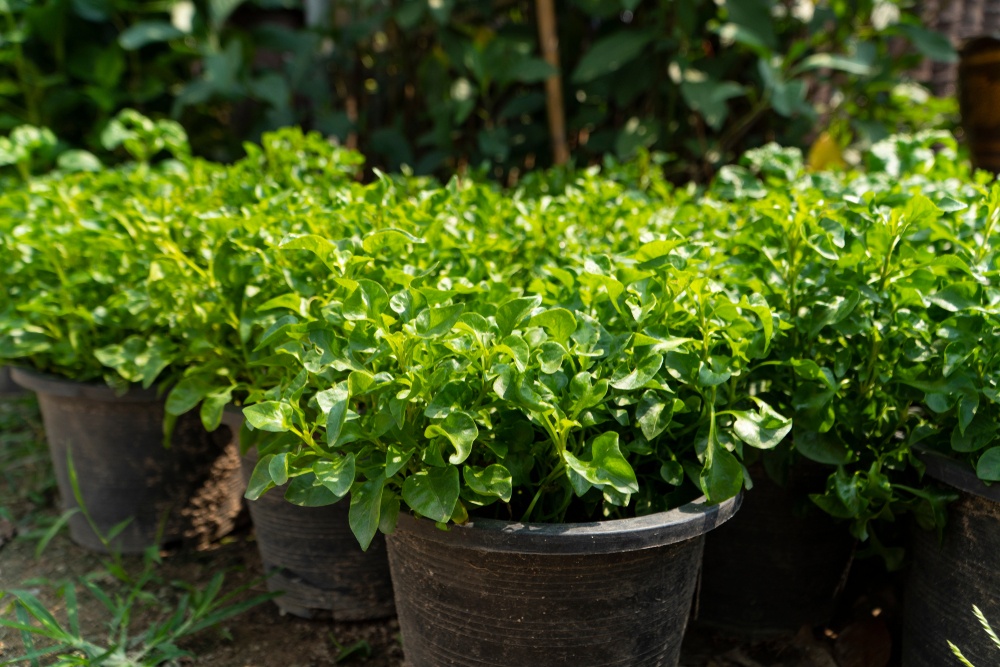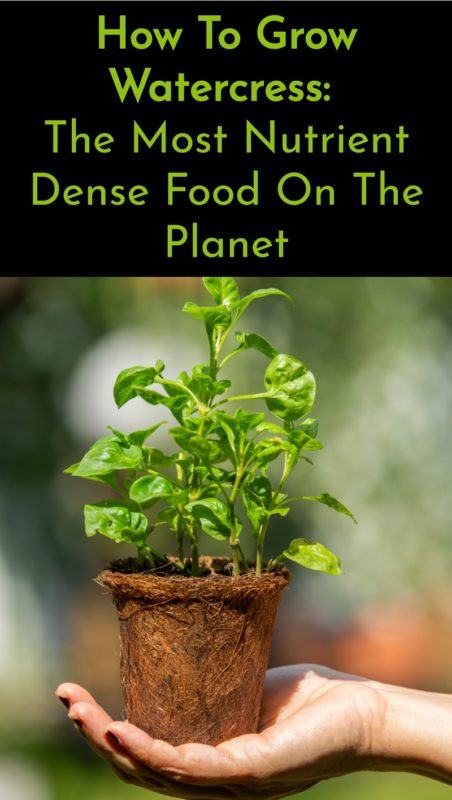
Native to Europe and Asia, watercress (Nasturtium officinale) is a perennial semi-aquatic plant within the mustard family.
Bearing small rounded leaves on a hollow stem, it has been naturalized in North America and can be found growing along the edges of cool streams, lakes, and rivers, either fully submerged or poking through the water’s surface.
Watercress, like its close cousins radish and wasabi, has a spicy flavor that adds a pleasant zing to any dish. It’s a nutritional powerhouse too, with far reaching benefits for the immune system, heart health, bone density, and cognition…
6 Reasons To Grow Watercress
1. Watercress Is Extremely Nutrient Dense
Topping the list of nutrient dense foods, watercress is just 3.7 calories per cup but provides the full daily value (DV) of vitamin K, is a good source of vitamins A, C, and E, and has smaller amounts of minerals like calcium and manganese:
| Per Cup of Watercress,raw | % of DV | |
| Calories | 3.7 | |
| Protein | 0.8 g | 2% |
| Vitamin A | 1085 IU | 22% |
| Vitamin C | 14.6 mg | 24% |
| Vitamin E | 0.3 mg | 2% |
| Vitamin K | 85 mcg | 106% |
| Thiamin | 0.0 mg | 2% |
| Riboflavin | 0.0 mg | 2% |
| Vitamin B6 | 0.0 mg | 2% |
| Folate | 3.1 mcg | 1% |
| Pantothenic Acid | 0.1 mg | 1% |
| Calcium | 40.8 mg | 4% |
| Magnesium | 7.1 mg | 2% |
| Phosphorus | 20.4 mg | 2% |
| Potassium | 112 mg | 3% |
| Manganese | 0.1 mg | 4% |
2. Watercress Is Rich In Antioxidants
Watercress is a member of the Brassicaceae family, a diverse group of cruciferous vegetables that include cabbage, broccoli, and arugula. Cruciferous vegetables are typically high in micronutrients, are enriched with phytochemicals, and have been associated with a reduced risk of several chronic diseases like cancer, cardiovascular disease, and dementia.
Comparing the phenolic content and antioxidant activity of 12 cruciferous veggies, a 2018 study published in Molecules found that watercress was particularly high in ferulic acid, p-coumaric acid, kaempferol, quercetin, and rutin. In terms of total phenolic content, watercress received among the highest scores (1.44), coming in behind arugula (1.93) and Brussels sprouts (1.92) but ahead of broccoli (1.06), bok choy (0.78), and daikon radish (0.16).
Watercress also displayed the greatest ability to neutralize free radicals. It had the highest oxygen radical absorbance capacity (ORAC) of all the cruciferous vegetables, with a score of 32.92; more than arugula (32.08), Brussels sprouts (26.67), broccoli (23.09), and cauliflower (9.53).
3. Watercress Is An Excellent Source Of Vitamin K
As noted above, each cup of watercress provides over 100% of the daily value for vitamin K. And having the recommended intake of vitamin K has plenty of benefits for the circulatory system, bones, and overall health.
Best known as the coagulation vitamin, vitamin K is essential for blood clotting. Without enough of it, blood would not turn from a liquid into a gel after a physical injury, and we would bleed uncontrollably.
Vitamin K is also keeps blood moving in the circulatory system by preventing plaque from building up in the arteries. The hardening of the blood vessels leads to heart attack, stroke, and aneurysm, but people who eat plenty of vitamin K foods have a much lower risk of cardiovascular diseases.
Studies have also shown that eating high to moderate amounts of vitamin K foods each day also helps keep bones strong. People who ensure they eat it every day nearly halve the risk for hip fractures, while people with low vitamin K intake have lower bone mineral density.
Vitamin K is great brain food too. Certain fats found in the brain, called sphingolipids, depend on vitamin K proteins to function properly. Studies on vitamin K and cognitive health have found that older adults who eat plenty of vitamin K have better autobiographical memory and fewer complaints about forgetfulness.
4. Watercress May Reduce Cancer Risk
All vegetables of the Brassica family have been linked to a reduced risk of some cancers, including lung, colon, and stomach cancer. Cruciferous vegetables are differentiated from other cancer-fighting fruits and veggies due to the presence of glucosinolates – or mustard oils – that convert to isothiocyanates when cut or chewed. Isothiocyanates are potent anti-cancer agents that exert detoxifying and apoptosis effects on cancer cells.
Watercress, specifically, shows much promise as a cancer preventative according to a small study published in 2007. In it, 60 healthy men and women supplemented with 85 grams of raw watercress each day for eight weeks in addition to their regular diets. Researchers discovered that higher watercress consumption increased antioxidants (vitamin C, lutein, and vitamin E) in the blood while also limiting DNA damage in lymphocytes, a class of white blood cells that naturally protect against cancer while boosting overall immunity.
5. Watercress Boosts The Immune System
Found in the lymphatic system, lymphocytes are made up of B cells, T cells, and natural killer cells that are vital to immune system function. These cells perform various life-saving tasks, such as making antibodies that block and destroy foreign pathogens, helper cells that coordinate immune response, and cells that are able to identify and kill cells that are infected by a virus or have become cancerous. Since watercress helps protect against damage to lymphocytes, it is beneficial for the immune system as a whole.
Additionally, each cup of watercress contains 24% of the daily value for vitamin C, a potent antioxidant that protects numerous molecules in the body. It plays an important role in the immune system by stimulating the production and function of white blood cells, while at the same time, protecting them from oxidative stress.
6. Watercress Is A Versatile Food
Although it is typically used as a salad green, the peppery, piquant leaves of the watercress plant can be incorporated into your diet in a variety of ways:
Watercress Soup – For a soup with a bite, this creamy puree includes potatoes and onions.
Watercress Salad – While there are plenty of renditions of watercress salad, this one is topped with feta, healthful beets, and a lemon-shallot vinaigrette.
Watercress-Walnut Pesto – An alternative to the usual basil and pine nut sauce, this pesto is just as yummy on pasta or pizza.
Watercress Salsa Verde – Excellent on grilled fish and other meats, this green salsa uses watercress in lieu of tomatillos along with olives, capers, anchovies, parsley, tarragon, garlic, dijon mustard, and lemon zest.
Watercress Bruschetta – Simply add some chopped watercress to this traditional antipasto.
Watercress Quiche – Buttery, peppery, and creamy, this quiche recipe is filled with salmon but there are so many other variations you could make.
Watercress Mayonnaise – Make this spicy mayo for sandwiches, salad dressings, or as a veggie dip.
You can find more watercress recipes here.
How To Grow Watercress At Home
Watercress is a sun and water loving perennial plant, hardy in USDA zones 6 to 9. Though it feels most at home in cool flowing streams, creeks, and springs, watercress easily adapts to home gardening set ups.
Ensure you use high quality non-GMO watercress seeds. This twin pack of 500 seeds from Seeds Needs is the best reviewed on Amazon. You’ll also find seeds in your local garden center
Light Requirements – Plant watercress in a sunny spot that receives at least 6 hours of sunlight each day.
Soil – Grow watercress in rich organic soil. Before sowing, apply compost generously to a depth of 6 to 8 inches. If growing watercress in containers, use a soilless mix with peat and perlite.
Sowing – Sow seeds directly in the ground, a ¼ inch deep, about three weeks before your frost-free date. Watercress seeds germinate best under cooler conditions, between 50° to 60°F. Keep the growing medium wet at all times and seeds should sprout in about 7 days.
Watering – The biggest challenge to growing watercress is ensuring the media never dries out and is always wet (not just moist). When possible, choose a site that is naturally wet – a water feature such as a stream, a marshy area of your yard, or even a spot next to a downspout would work. Alternatively, watercress will adapt to container gardening provided you place pots on deep trays with 2 to 3 inches of water so that the roots are always submerged. Top up the tray water daily and give the plant a good flush with water at least once per week.
Fertilizer – If you amended your soil prior to sowing, watercress shouldn’t need much additional fertilization. However, if leaves are dark green, stunted, scotched, or yellowing, use a balanced booster like compost tea.
Harvest – Watercress tastes best when harvested in the cooler temperatures of spring and fall, before it has begun to flower. Take cuttings when plants are 6 inches tall and bear dime-sized leaves. Leave 4 inches of growth and watercress will give you another harvest in autumn. Watercress also makes for an excellent micro green that can be enjoyed when it is just two inches tall.
Storage – Watercress is fairly delicate and will keep in the fridge for up to two days. Ensure nothing goes to waste by only taking cuttings you plan to eat that day.
Pin This To Save For Later

